earthquake
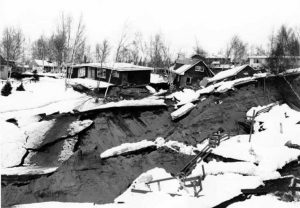
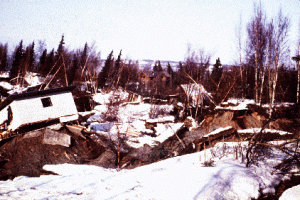 The earthquake struck at 5:35pm local time on Good Friday, March 27, 1964. Its epicenter was 12.4 miles north of Prince William Sound, 78 miles east of Anchorage and 40 miles west of Valdez. Across southcentral Alaska, ground fissures, collapsing structures, and tsunamis resulting from the earthquake caused about 131 deaths. Soil liquefaction, fissures, landslides, and other ground failures caused major structural damage in several communities and much damage to property. Anchorage was hit very hard, and sustained great destruction or damage to many inadequately earthquake-engineered houses, buildings, paved streets, sidewalks, water and sewer mains, electrical systems, and other man-made equipment, particularly in the several landslide zones along Knik Arm. Two hundred miles southwest, some areas near Kodiak were permanently raised by 30 feet. Southeast of Anchorage, areas around the head of Turnagain Arm near Girdwood and Portage dropped as much as 8 feet, requiring reconstruction and fill to raise the Seward Highway above the new high tide mark.
The earthquake struck at 5:35pm local time on Good Friday, March 27, 1964. Its epicenter was 12.4 miles north of Prince William Sound, 78 miles east of Anchorage and 40 miles west of Valdez. Across southcentral Alaska, ground fissures, collapsing structures, and tsunamis resulting from the earthquake caused about 131 deaths. Soil liquefaction, fissures, landslides, and other ground failures caused major structural damage in several communities and much damage to property. Anchorage was hit very hard, and sustained great destruction or damage to many inadequately earthquake-engineered houses, buildings, paved streets, sidewalks, water and sewer mains, electrical systems, and other man-made equipment, particularly in the several landslide zones along Knik Arm. Two hundred miles southwest, some areas near Kodiak were permanently raised by 30 feet. Southeast of Anchorage, areas around the head of Turnagain Arm near Girdwood and Portage dropped as much as 8 feet, requiring reconstruction and fill to raise the Seward Highway above the new high tide mark.
I came to know of this horrific 9.2 magnitude earthquake when my husband, Bob and I were on a cruise to Alaska. The cruise ended in Anchorage, and we had taken an extra day for exploration of the area. My first notice of this Alaskan earthquake was on a shuttle ride from the airport to Anchorage proper. We had the day before our flight at 10:30pm, so we stored our luggage at the airport and took the shuttle back into town. The shuttle driver took us by the Turnagain Heights neighborhood, the current location of Earthquake Park. She told us that the soil there had liquified and homes were swallowed…some almost completely, leaving only their chimneys above ground, while others were swept out to sea in the ensuing tsunami waves. I couldn’t shake the dreadful feeling of the horror that had happened there. A stop in a museum, including a documentary about the 1964 Alaskan earthquake, told me that the earthquake that happened in the modern-day Earthquake Park, was the 1964 Alaskan earthquake. Of course, I was only 8 years old when it happened, so I guess that it is not so odd that I hadn’t heard of it.
We began a much longer than expected walk along the Tony Knowles Coastal Bicycle Trail. Of course, people were walking on the trail too, but we had no idea how long the walk back to the airport would be. Nevertheless, the walk took us through Earthquake Park, and…well, I have only noticed such an air of heaviness in one other place…Gettysburg Battlefield. There is something about being in a place where so much death and destruction occurred. I takes on an air of being “hallowed ground” somehow. President Lincoln knew what he was talking about when he gave the Gettysburg Address. Walking through Earthquake Park, you could see the rippled ground, where the liquified soil had rolled back and forth during the earthquake. We didn’t get off the trail, so if there were chimneys visible near us, we didn’t see them, but I was moved to think that beneath our feet, there might be houses that people had lived in. I didn’t know if the people who had lived there were there still, or if 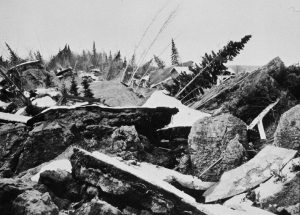
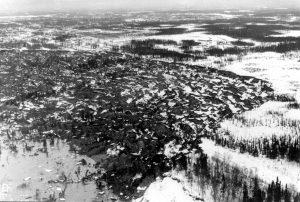 they had been located and buried after the disaster. Whatever the case may be, I left the area feeling very different than I had just two days earlier. I had been in the exact place where such a devastating disaster had happened, and I have never forgotten that place, just as I have never forgotten the feeling I felt at Gettysburg. Some things just have a profound effect on us…forever.
they had been located and buried after the disaster. Whatever the case may be, I left the area feeling very different than I had just two days earlier. I had been in the exact place where such a devastating disaster had happened, and I have never forgotten that place, just as I have never forgotten the feeling I felt at Gettysburg. Some things just have a profound effect on us…forever.
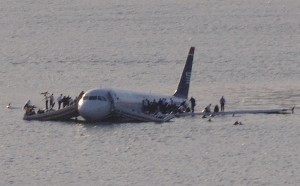 Imagine, if you can these days, a world without photography. Cameras are almost always at our fingertips now. We don’t need to carry a camera with us, we have our phones, and we are able to take all the pictures we want. We can document everything from the birth of our children, to a pretty sunset in the back yard. We document our smiles, frowns, and totally shocked looks. In so many ways, personal photography has changed our lives, but one way in particular is in documenting history. Most people don’t think our what they are doing as documenting history exactly, but it certainly can be. People have captured plane crashes, rocket launches, car accidents, forest fires, volcano eruptions, and earthquakes…just to name
Imagine, if you can these days, a world without photography. Cameras are almost always at our fingertips now. We don’t need to carry a camera with us, we have our phones, and we are able to take all the pictures we want. We can document everything from the birth of our children, to a pretty sunset in the back yard. We document our smiles, frowns, and totally shocked looks. In so many ways, personal photography has changed our lives, but one way in particular is in documenting history. Most people don’t think our what they are doing as documenting history exactly, but it certainly can be. People have captured plane crashes, rocket launches, car accidents, forest fires, volcano eruptions, and earthquakes…just to name 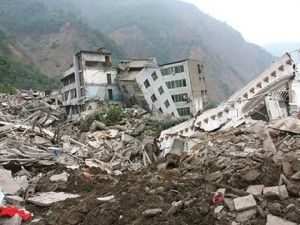 a few. Those things might not be history today, but in a couple of years, they are, and in many cases, one person had the only picture of the historic event.
a few. Those things might not be history today, but in a couple of years, they are, and in many cases, one person had the only picture of the historic event.
Would history be documented without photography? Of course, but it would happen by word of mouth, and later the written word…newspapers, books and such. The problem with that is that those accounts can only tell the part of history that someone saw or was a part of. But, what if they missed something? Humans so often miss the small details, but a camera or video camera, doesn’t miss as much. Once a picture is taken, an event is documented…and every small detail can be re-examined at will. Pictures have made the difference between knowing the cause and never knowing the cause. Pictures have proven fault 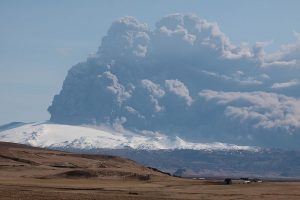 without a doubt. They have been the difference between an innocent person being falsely accused, and getting to the truth.
without a doubt. They have been the difference between an innocent person being falsely accused, and getting to the truth.
These days, with a camera built into our phone, we can, and do, document many events of our lives. And we document history…some of it amazing, and some of it devastating. It’s all part of the ability to capture things in real time. You have to take the bad with the good, because unfortunately, not all of history is beautiful. Some of it is completely ugly, but it still needs to be documented. Pictures have become necessary, because without photography, much of the full documentation of history would be lost.
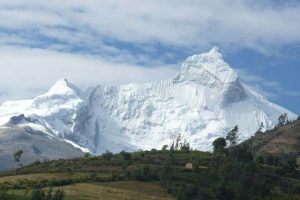 It seems that before every accepted type of warning system, there is a period of time when the warnings are either ignored by officials or the officials worry that such a warning will cause a panic among the people. In retrospect, however, the officials always wish that they had allowed the warnings to be posted, so that lives could have been saved. I can understand how the idea of mass panic could be a bit scary for officials, and people often don’t act in a way that could produce an orderly evacuation, in which everyone evacuates as if nothing is wrong.
It seems that before every accepted type of warning system, there is a period of time when the warnings are either ignored by officials or the officials worry that such a warning will cause a panic among the people. In retrospect, however, the officials always wish that they had allowed the warnings to be posted, so that lives could have been saved. I can understand how the idea of mass panic could be a bit scary for officials, and people often don’t act in a way that could produce an orderly evacuation, in which everyone evacuates as if nothing is wrong.
David Bernays and Charles Sawyer were two American scientists who were exploring the area around Yungay, Peru. They were climbing nearby Mount Huascarán, when they saw something that alarmed them. They noticed quite a bit of loose bedrock under a glacier. The scientists also knew that the region was prone to earthquakes. The mix of those two things, possible disasters on their own, could be catastrophic if they happened together. Bernays and Sawyer tried to save the residents of Yungay, Peru from the huge avalanche that was a very real possibility.
At the warning, the government became so outraged by the warning the scientists issued, that they ordered the them to take it back or go to prison. That was a big threat, and these were American scientists in a foreign country. I’m sure that the men were justifiably terrified. As a result of the threat and the fear it brought, the two scientists fled the country. Several years later, the men were proven right, when an avalanche killed most of Yungay’s 20,000 residents. I’m sure that being proven right didn’t do much for the two scientists’ feelings of horror at the very disaster that they had so correctly predicted. This was not going to be an “I told you so” moment. It was simply a tragedy…and it could have been prevented, if anyone had listened.
The May 31, 1970 undersea earthquake off the coast of Casma and Chimbote, north of Lima, triggered one of the most cataclysmic avalanches in recorded history. The avalanche wiped out the entire highland town of Yungay and most of its 25,000 inhabitants. Around 3:23pm, local time, while most people were tuned in to the Italy-Brazil FIFA World Cup Match, an earthquake struck the Peruvian departments of Ancash and La Libertad. The quake’s epicenter was located in the Pacific Ocean, where the Nazca Plate is subducted by the South American Plate, and recorded a magnitude of 8.0 on the Richter scale, with an intensity of up to 8 on the Mercalli scale. The quake lasted 45 seconds, and crumbled adobe homes, bridges, roads and schools across 83,000 square kilometers, an area larger than Belgium and the Netherlands combined. It was registered as one of the worst earthquakes ever to be experienced in South America. Damage and casualties were reported as far 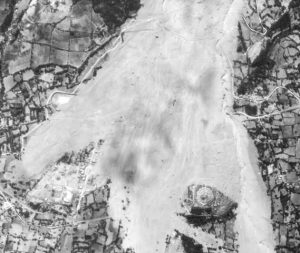 as Tumbes, Iquitos and Pisco, as well as in some parts of Ecuador and Brazil…but in Yungay, a small highland town in the picturesque Callejon de Huaylas, founded by Domingo Santo Tomás in 1540, the earthquake triggered an even greater calamity.
as Tumbes, Iquitos and Pisco, as well as in some parts of Ecuador and Brazil…but in Yungay, a small highland town in the picturesque Callejon de Huaylas, founded by Domingo Santo Tomás in 1540, the earthquake triggered an even greater calamity.
Following the quake, the glacier on the north face of Mount Huascarán broke free, causing 10 million cubic meters of rock, ice and snow to break away and tear down its slope at more than 120 miles, per hour. As it thundered down toward Yungay, and the town of Ranrahirca on the other side of the ridge, the wave of debris picked up more glacial deposits and began to spit out mud, dust, and boulders. By the time it reached the valley, just three minutes later, the 3,000 feet wide wave was estimated to have consisted of about 80 million cubic meters of ice, mud, and rocks. Within moments, what was Yungay and its 25,000 inhabitants, many of whom had rushed into the church to pray after the earthquake struck, were buried and crushed by the landslide. The smaller village of Ranrahirca was buried as well, the second time in a decade, but it is the image of lone surviving palm trees in the Yungay cemetery that is burned into Peru’s memory.
“We were on our way from Yungay to Caraz when the earthquake struck,” survivor Mateo Casaverde recalls. “When we stepped out of the car, the earthquake was almost over. Then we heard a deep, low rumble, something distinct from the noise an earthquake makes, but not too different. It came from the Huascarán. Then we saw, half-way between Yungay and the mountain, a giant cloud of dust. Part of the Huascarán was coming toward us. It was approximately 3:24pm. Where we were, the only place that offered us relative security, was the cemetery, built upon an artificial hill, like a pre-Incan tomb. We ran approximately 100 meters before we got to the cemetery. Once I reached the top, I turned to see Yungay. I could clearly see a giant wave of gray mud, about 60 meters high. Moments later, the landslide hit the cemetery, about five meters below our feet. The sky went dark because of all the dust, mostly from all of the destroyed homes. We turned to look, and Yungay, as well as its thousands of inhabitants, had completely disappeared.”
The reported death toll from what came to be known as Peru’s Great Earthquake totaled more than 74,000 people. About 25,600 were declared missing, over 143,000 were injured and more than one million left homeless. The city of Huaraz was rubble, the valley buried in mud, and coastal towns such as Casma were also shaken to the ground. In Yungay, only some 350 people survived, including the few who were able to climb to the town’s elevated step-like cemetery. Built between 1892 and 1903, the cemetery was designed by Swiss architect Arnoldo Ruska, who also died as a result of the landslide. Among the survivors were 300 children, who had been taken to the circus at the local stadium, set on higher ground and on the outskirts of the town.
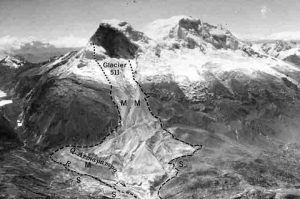 Today, Yungay is a national cemetery and the Huascarán’s victims are still vividly remembered. Because the Peruvian government has forbidden excavation in the area, crosses and tombs mark the spots where homes once stood, engraved with the names of those never found. A crushed intercity bus, four of the original palm trees that once crowned the city’s main plaza and remnants of the cathedral still stand. Though life goes on and a new Yungay has since been rebuilt, a few miles away from the original city, Peru does not forget. In 2000, in memory of the victims of the deadliest seismic disaster in the history of Latin America, the government declared May 31 “Natural Disaster Education and Reflection Day.”
Today, Yungay is a national cemetery and the Huascarán’s victims are still vividly remembered. Because the Peruvian government has forbidden excavation in the area, crosses and tombs mark the spots where homes once stood, engraved with the names of those never found. A crushed intercity bus, four of the original palm trees that once crowned the city’s main plaza and remnants of the cathedral still stand. Though life goes on and a new Yungay has since been rebuilt, a few miles away from the original city, Peru does not forget. In 2000, in memory of the victims of the deadliest seismic disaster in the history of Latin America, the government declared May 31 “Natural Disaster Education and Reflection Day.”
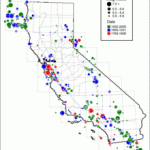 Earthquakes can happen anywhere, but there are areas that are more prone to earthquakes than other areas. When we think about that, we think of Alaska, California, or Japan, all of which experience daily earthquakes. Of course, there are many other places that get a lot of earthquakes. One such place is in Italy. The area around Sicily and Calabria are known as la terra ballerina, “the dancing land,” for the periodic seismic activity that strikes the region. I would have thought that with 12,000 earthquakes a year in Alaska, or 10,000 earthquakes a year in California, or 1,500 earthquakes in Japan, that any of these places would be called “the dancing land” before the area of Sicily and Calabria, which doesn’t have nearly as many.
Earthquakes can happen anywhere, but there are areas that are more prone to earthquakes than other areas. When we think about that, we think of Alaska, California, or Japan, all of which experience daily earthquakes. Of course, there are many other places that get a lot of earthquakes. One such place is in Italy. The area around Sicily and Calabria are known as la terra ballerina, “the dancing land,” for the periodic seismic activity that strikes the region. I would have thought that with 12,000 earthquakes a year in Alaska, or 10,000 earthquakes a year in California, or 1,500 earthquakes in Japan, that any of these places would be called “the dancing land” before the area of Sicily and Calabria, which doesn’t have nearly as many.
Nevertheless, the name was given and it stuck. While it may not have as many, the ones that hit there seem to be especially devastating. In 1693, 60,000 people were killed in southern Sicily by an earthquake, and in 1783 most of the Tyrrenian coast of Calabria was leveled by a massive earthquake that 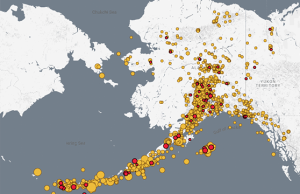 killed 50,000. The quake of 1908 was particularly costly in terms of human life because it struck at at dawn, catching most people at home in bed rather than in the relative safety of the streets or fields. The December 28, 1908 earthquake which struck at 5:20am was the most destructive earthquake in recorded European history strikes the Straits of Messina in southern Italy. The cities of Messina in Sicily and Reggio di Calabria on the Italian mainland were leveled by the devastating quake. The earthquake and tsunami it caused killed an estimated 100,000 people. The main shock registered an estimated 7.5 magnitude on the Richter scale. It caused a devastating tsunami with 40-foot waves that washed over coastal towns and cities. The two major cities on either side of the Messina Straits–Messina and Reggio di Calabria, had about 90 percent of their buildings destroyed. The quake cut telegraph lines and damaged railway lines, seriously slowing down the relief efforts. To make matters worse, many of the remaining buildings were destroyed by hundreds of smaller
killed 50,000. The quake of 1908 was particularly costly in terms of human life because it struck at at dawn, catching most people at home in bed rather than in the relative safety of the streets or fields. The December 28, 1908 earthquake which struck at 5:20am was the most destructive earthquake in recorded European history strikes the Straits of Messina in southern Italy. The cities of Messina in Sicily and Reggio di Calabria on the Italian mainland were leveled by the devastating quake. The earthquake and tsunami it caused killed an estimated 100,000 people. The main shock registered an estimated 7.5 magnitude on the Richter scale. It caused a devastating tsunami with 40-foot waves that washed over coastal towns and cities. The two major cities on either side of the Messina Straits–Messina and Reggio di Calabria, had about 90 percent of their buildings destroyed. The quake cut telegraph lines and damaged railway lines, seriously slowing down the relief efforts. To make matters worse, many of the remaining buildings were destroyed by hundreds of smaller 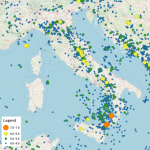 tremors over subsequent days. These tremors injured or killed rescuers. On December 30, King Victor Emmanuel III arrived aboard the battleship Napoli to inspect the devastation.
tremors over subsequent days. These tremors injured or killed rescuers. On December 30, King Victor Emmanuel III arrived aboard the battleship Napoli to inspect the devastation.
To make matters worse, a steady rain fell on the ruined cities, forcing the dazed and injured survivors, clad only in their nightclothes, to take shelter in caves, grottoes, and impromptu shacks built out of materials salvaged from the collapsed buildings. Veteran sailors could barely recognize the shoreline because long stretches of the coast had sunk several feet into the Messina Strait. The devastation was horrific. After all that, I can see why it is called la terra ballerina, “the dancing land.”
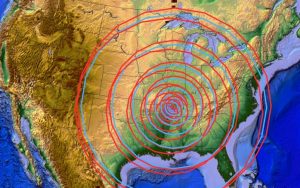 After an earthquake, especially a big quake, you start looking for damage or reports of damage. You will invariably find damage, unless the quake occurred in an area that is completely unsettled or in the ocean. Still, you have to look well beyond the epicenter of the quake…sometimes as far away as 6,000 miles. A big quake can shake things up for many miles. On December 16, 1811 a series of Intraplate earthquakes began, that shook apart the area of the New Madrid fault in present day Missouri, around the Mississippi River. Intraplate earthquakes are often confused with Interplate earthquakes, but are fundamentally different in origin, occurring within a single plate rather than between two tectonic plates on a plate boundary, like the Interplate earthquake does. The specifics of the mechanics by which they occur, as well as the intensity of the stress drop which occurs after the earthquake also differentiate the two types of events. Intraplate earthquakes have, on average, a higher stress drop than that of an Interplate earthquake and generally higher intensity,meaning they can bring more damage. These Intraplate earthquakes continued until February 7, 1812. The first earthquake on December 16th had its epicenter in northeast Arkansas and measured up to an 8 on the Mercalli intensity scale. This earthquake was followed by another six hours later, and two more on January 23rd and February 7th, respectively. The third quake caused warping, magma eruptions, fissuring and landslides. While these were unusual events for the area, the were far from the most unusual events related to this series of quakes.
After an earthquake, especially a big quake, you start looking for damage or reports of damage. You will invariably find damage, unless the quake occurred in an area that is completely unsettled or in the ocean. Still, you have to look well beyond the epicenter of the quake…sometimes as far away as 6,000 miles. A big quake can shake things up for many miles. On December 16, 1811 a series of Intraplate earthquakes began, that shook apart the area of the New Madrid fault in present day Missouri, around the Mississippi River. Intraplate earthquakes are often confused with Interplate earthquakes, but are fundamentally different in origin, occurring within a single plate rather than between two tectonic plates on a plate boundary, like the Interplate earthquake does. The specifics of the mechanics by which they occur, as well as the intensity of the stress drop which occurs after the earthquake also differentiate the two types of events. Intraplate earthquakes have, on average, a higher stress drop than that of an Interplate earthquake and generally higher intensity,meaning they can bring more damage. These Intraplate earthquakes continued until February 7, 1812. The first earthquake on December 16th had its epicenter in northeast Arkansas and measured up to an 8 on the Mercalli intensity scale. This earthquake was followed by another six hours later, and two more on January 23rd and February 7th, respectively. The third quake caused warping, magma eruptions, fissuring and landslides. While these were unusual events for the area, the were far from the most unusual events related to this series of quakes.
After the February earthquake, it was reported that the Mississippi River began running backwards, and event that lasted for several hours and caused two temporary waterfalls to develop. The upthrusting of land caused the formation of Reelfoot Lake 15 miles south of the epicenter while the crushing of quartz crystals underground created flashing lights that lit up the sky. Boatmen on flatboats actually survived this experience and lived to tell the tale. Incredibly, the earthquakes could be felt over 50,000 square miles. That is shocking when you think about the fact that the 1906 San Francisco earthquake, which was deadly enough in its own right, was felt over 6,000 square miles.
The New Madrid earthquakes were the biggest earthquakes in American history. While they occurred in the 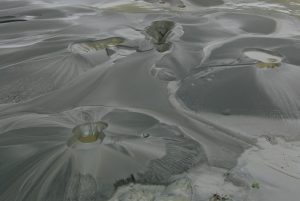 central Mississippi Valley, they were felt as far away as New York City, Boston, Montreal, and Washington D.C. President James Madison and his wife Dolly even felt them in the White House, and church bells rang in Boston. From December 16, 1811 through March of 1812 there were over 2,000 smaller earthquakes in the central Midwest, and between 6,000-10,000 earthquakes in the Bootheel of Missouri where New Madrid is located near the junction of the Ohio and Mississippi Rivers. In the known history of the world, no other earthquakes have lasted so long or produced so much evidence of damage as the New Madrid earthquakes. Three of the earthquakes are on the list of America’s top earthquakes: the first one on December 16, 1811, a magnitude of 8.1 on the Richter scale; the second on January 23, 1812, at 7.8; and the third on February 7, 1812, at as much as 8.8 magnitude.
central Mississippi Valley, they were felt as far away as New York City, Boston, Montreal, and Washington D.C. President James Madison and his wife Dolly even felt them in the White House, and church bells rang in Boston. From December 16, 1811 through March of 1812 there were over 2,000 smaller earthquakes in the central Midwest, and between 6,000-10,000 earthquakes in the Bootheel of Missouri where New Madrid is located near the junction of the Ohio and Mississippi Rivers. In the known history of the world, no other earthquakes have lasted so long or produced so much evidence of damage as the New Madrid earthquakes. Three of the earthquakes are on the list of America’s top earthquakes: the first one on December 16, 1811, a magnitude of 8.1 on the Richter scale; the second on January 23, 1812, at 7.8; and the third on February 7, 1812, at as much as 8.8 magnitude.
In addition to the Mississippi River running backwards, there were numerous other strange happenings too. As the area experienced more than 2,000 earthquakes in five months, people learned that most of the crevices opening up during an earthquake ran from north to south, so when the earth began moving, they would chop down trees in an east-west direction and hold on using the tree as a bridge. Unfortunately, there were also “missing people” who were most likely swallowed up by the earth. Some earthquake fissures were as long as five miles. Another strange event, though not totally unusual was the sand boils that formed. A sand boil is sand and water that come out onto the ground surface during an earthquake as a result of liquefaction at shallow depth. The world’s largest sand boil was created by the New Madrid earthquake. It is 1.4 miles long and 136 acres in extent, located in the Bootheel of Missouri, about eight miles west of Hayti, Missouri. Locals call it “The Beach.” Other, much smaller, sand boils were also found throughout the area. Small pellets up to golf ball sized tar balls were found in sand boils and fissures. Known as Seismic Tar Balls, they are petroleum that has been solidified, or “petroliferous nodules.” Lights flashed from the ground, caused by quartz crystals being squeezed. Generally known as Earthquake Lights, the phenomena is scientifically called “seismoluminescence.”
Water thrown up by an earthquake was lukewarm. It is speculated that the shaking caused the water to heat up and/or quartz light heated the water. The skies turned dark during the earthquakes, so dark that lighted lamps didn’t help. The air smelled bad, and it was hard to breathe. It is speculated that it was smog containing 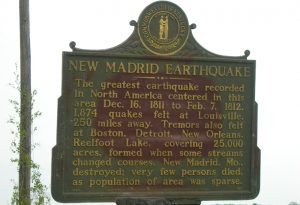 dust particles caused by the eruption of warm water into cold air. Sounds of distant thunder and loud explosions accompanied the earthquakes. People reported strange behavior by animals before the earthquakes. They were nervous and excited. Domestic animals became wild, and wild animals became tame. Snakes came out of the ground from hibernation. Flocks of ducks and geese landed near people. I’m sure that some of these events could be viewed as normal during n earthquake, but certainly some of them or even the mere numbers of these phenomena could be viewed as very strange, and I don’t know that there has ever been a more strange earthquake before or since.
dust particles caused by the eruption of warm water into cold air. Sounds of distant thunder and loud explosions accompanied the earthquakes. People reported strange behavior by animals before the earthquakes. They were nervous and excited. Domestic animals became wild, and wild animals became tame. Snakes came out of the ground from hibernation. Flocks of ducks and geese landed near people. I’m sure that some of these events could be viewed as normal during n earthquake, but certainly some of them or even the mere numbers of these phenomena could be viewed as very strange, and I don’t know that there has ever been a more strange earthquake before or since.
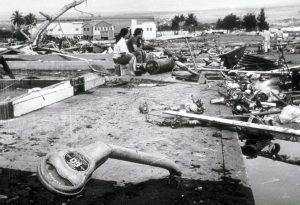 These days, scientist and inventors have collaborated to develop early warning systems for just about any possible disaster, and when everything works as it should, and people heed the warnings, loss of life can often be avoided. Having the technology is great, but technology can’t make human beings do the right things…unfortunately. On May 22, 1960, twelve years after tsunami warnings were developed, and with the warning system in good working order, a massive 9.5 earthquake struck off the coast of Chili. It was the largest earthquake ever recorded. Unfortunately, we don’t really have an earthquake warning, and so without warning, 1655 people lost their lives in Chili and 3,000 injured in the quake. Two million people were made homeless, and damage was estimated at $550 million. The earthquake, involving a severe plate shift, caused a large displacement of water off the coast of southern Chile at 3:11pm. Traveling at speeds in excess of 400 miles per hour, the tsunami moved west and north. On the west coast of the United States, the waves caused an estimated $1 million in damages, but were not deadly. Everyone assumed that the worst was over.
These days, scientist and inventors have collaborated to develop early warning systems for just about any possible disaster, and when everything works as it should, and people heed the warnings, loss of life can often be avoided. Having the technology is great, but technology can’t make human beings do the right things…unfortunately. On May 22, 1960, twelve years after tsunami warnings were developed, and with the warning system in good working order, a massive 9.5 earthquake struck off the coast of Chili. It was the largest earthquake ever recorded. Unfortunately, we don’t really have an earthquake warning, and so without warning, 1655 people lost their lives in Chili and 3,000 injured in the quake. Two million people were made homeless, and damage was estimated at $550 million. The earthquake, involving a severe plate shift, caused a large displacement of water off the coast of southern Chile at 3:11pm. Traveling at speeds in excess of 400 miles per hour, the tsunami moved west and north. On the west coast of the United States, the waves caused an estimated $1 million in damages, but were not deadly. Everyone assumed that the worst was over. 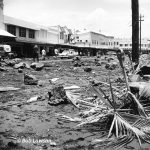
Nevertheless, warnings were sent to the Hawaiian islands. The Pacific Tsunami Warning System properly and warnings were issued to Hawaiians six hours before the wave’s expected arrival. The response of some people, however, was reckless and irresponsible. Some people ignored the warnings, and others actually headed to the coast in order to view the wave. Arriving 15 hours after the quake, only a minute after predicted, the tsunami destroyed Hilo Bay, on the island of Hawaii. Thirty five foot waves bent parking meters to the ground and wiped away most buildings, destroying or damaging more than 500 homes and businesses. A 10 ton tractor was swept out to sea. Reports indicate that the 20 ton boulders making up the sea wall were moved 500 feet. Sixty-one people died in Hilo, the worst-hit area of the island chain. Damage was estimated at $75 million. This tsunami caused little damage elsewhere in the islands, where wave heights were in the 3-17 foot range. The tsunami continued to race further west across the Pacific. Ten thousand miles away from the earthquake’s epicenter. Japan, received warning, but wasn’t able to warn the people in harm’s way. At about 6pm, more than a day after the quake, the tsunami hit the Japanese islands of Honshu and Hokkaido. The 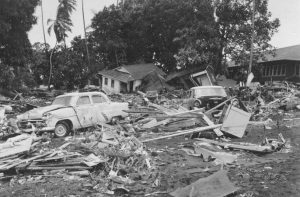 crushing wave killed 180 people, left 50,000 more homeless and caused $400 million in damages. The Philippines, also hit, saw 32 people dead or missing.
crushing wave killed 180 people, left 50,000 more homeless and caused $400 million in damages. The Philippines, also hit, saw 32 people dead or missing.
Tsunami warnings definitely save lives, but only if people will heed the warnings. As long as people decide that the warning doesn’t apply to them, and give in to their curiosity to go have a look, there will continue to be deaths. It seems a great shame that inventors and scientist work so hard to make a warning to save lives, and then some people refuse to do what is necessary to be safe after they have been warned. I simply don’t understand how people can ignore these warnings and take a chance with their lives.
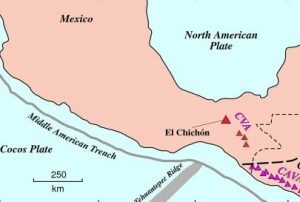 El Chichón was a volcano, in southern Mexico, that had not erupted for 130 years, meaning that no one who was alive on March 29, 1982 had ever seen it erupt. For most of the residents, who lived in the shadow of El Chichón, also known as Chinhonal, the 4,500 foot mountain seemed to pose no danger. Even when it did erupt, 130 years earlier, the eruption was minor. The people assumed that it was a dead volcano, and so ignored its potential for destruction and enjoyed the fertile soil its volcanic past provided.
El Chichón was a volcano, in southern Mexico, that had not erupted for 130 years, meaning that no one who was alive on March 29, 1982 had ever seen it erupt. For most of the residents, who lived in the shadow of El Chichón, also known as Chinhonal, the 4,500 foot mountain seemed to pose no danger. Even when it did erupt, 130 years earlier, the eruption was minor. The people assumed that it was a dead volcano, and so ignored its potential for destruction and enjoyed the fertile soil its volcanic past provided.
Then, in late 1981, two geologists, who were intrigued by hot springs and steaming gaps in the earth near the volcano, began an investigation that revealed increased seismic activity and the possibility of a major eruption of the volcano. Unfortunately, their report was ignored, because of the volcano’s quiet past. Thier complacence would 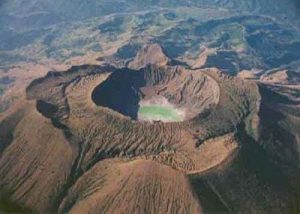 prove to be their downfall. Even when the ground began shaking on the night of March 28, the people did not heed the warning signs.
prove to be their downfall. Even when the ground began shaking on the night of March 28, the people did not heed the warning signs.
Then, at 5:15am the following morning, March 29, 1982, no one could miss the combination earthquake and eruption that exploded the mountain. The combination of the earthquake and the volcanic eruption turned the mountain into a crater. Ash was sent flying 60,000 feet in the air. About 150 people were killed when their roofs collapsed under raining volcanic debris. Two days later, ash from the eruption fell in Austin, Texas, many hundreds of miles to the north. The eruptions continued for over a week.
Most of the approximately 2,000 people killed by the eruption died from exposure to the pyroclastic flow, a 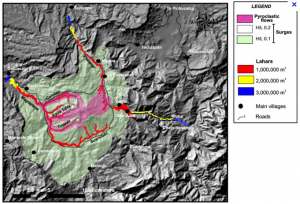 volatile mix of hot particles and gas. El Chichón lost its entire top, leaving only a large crater 1,000 feet deep, and less than 700 feet high, which was now shorter than the surrounding hills. Two more major eruptions occurred on April 3rd and 4th. In these eruptions, the debris was sent so high that it came down as virtual landslide on the surrounding villages. Trees and buildings were no match for the dirt and rocks. The debris also blocked streams, causing flooding in the area. Nine entire villages were destroyed and more than 100 square miles of farmland were unusable for years. Overall, the energy released by the eruptions, which were similar in scope to the Mount Saint Helens eruptions in Washington in 1980, was the equivalent of 8,000 one kiloton atomic bombs.
volatile mix of hot particles and gas. El Chichón lost its entire top, leaving only a large crater 1,000 feet deep, and less than 700 feet high, which was now shorter than the surrounding hills. Two more major eruptions occurred on April 3rd and 4th. In these eruptions, the debris was sent so high that it came down as virtual landslide on the surrounding villages. Trees and buildings were no match for the dirt and rocks. The debris also blocked streams, causing flooding in the area. Nine entire villages were destroyed and more than 100 square miles of farmland were unusable for years. Overall, the energy released by the eruptions, which were similar in scope to the Mount Saint Helens eruptions in Washington in 1980, was the equivalent of 8,000 one kiloton atomic bombs.
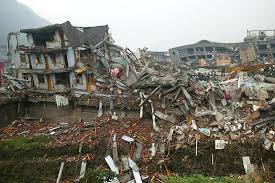 The majority of earthquakes are minor and cause little damage, They are quite common, and for the most part, we never hear about them. On the other hand, on January 23, 1556 an earthquake hit Shaanxi, China. While this didn’t even come close to being the largest earthquake ever recorded, it remains the deadliest to this day. Scientific investigation revealed that the magnitude of the quake was approximately 8.0 to 8.3. The largest earthquake in history was the 1960 Valdivia earthquake, registering 9.4 to 9.6. The Valdivia was without doubt much larger that the Shaanxi China quake, but the size of a quake isn’t the only thing that makes it the worst.
The majority of earthquakes are minor and cause little damage, They are quite common, and for the most part, we never hear about them. On the other hand, on January 23, 1556 an earthquake hit Shaanxi, China. While this didn’t even come close to being the largest earthquake ever recorded, it remains the deadliest to this day. Scientific investigation revealed that the magnitude of the quake was approximately 8.0 to 8.3. The largest earthquake in history was the 1960 Valdivia earthquake, registering 9.4 to 9.6. The Valdivia was without doubt much larger that the Shaanxi China quake, but the size of a quake isn’t the only thing that makes it the worst.
The epicenter of the Shaanxi quake was in the Wei River Valley in the Shaanxi Province, near the cities of Huaxian, Weinan and Huayin. In Huaxian, every single building and home collapsed, killing more than half the residents of the city, a number estimated in the tens of thousands. It was a similar  story in Weinan and Huayin. In some places, 60-foot-deep crevices opened in the earth. Serious destruction and death occurred as much as 300 miles away from the epicenter. The earthquake also triggered landslides, which contributed to the massive death toll. In all, an estimated 830,000 people lost their lives in the Shaanxi earthquake. Counting casualties is often imprecise after large-scale disasters, especially prior to the 20th century, but this disaster is still considered the deadliest of all time.
story in Weinan and Huayin. In some places, 60-foot-deep crevices opened in the earth. Serious destruction and death occurred as much as 300 miles away from the epicenter. The earthquake also triggered landslides, which contributed to the massive death toll. In all, an estimated 830,000 people lost their lives in the Shaanxi earthquake. Counting casualties is often imprecise after large-scale disasters, especially prior to the 20th century, but this disaster is still considered the deadliest of all time.
The quake struck in late evening, with aftershocks continuing through the following morning. A magnitude 8.0 to 8.3 earthquake isn’t close to the strongest tremor on record. However, the quake struck in the middle of a densely populated area with poorly constructed buildings and homes, resulting in the horrific death toll. Even if the number of deaths caused by the Shaanxi earthquake has been overestimated slightly, it would still rank as the worst disaster in history by a considerable margin. The earthquake and tsunami in Indonesia in 2004 is 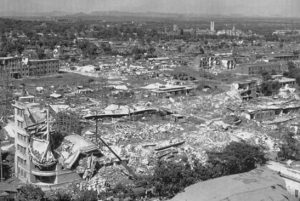 generally considered the second deadliest disaster in history.
generally considered the second deadliest disaster in history.
The local records indicate that, in addition to inspiring searches for the causes of earthquakes, this particular quake led the people in the region affected to search for ways to minimize the damage caused by such disasters. Many of the casualties in the quake were people who had been crushed by falling buildings. Thus, in the aftermath of the 1556 quake, many of the stone buildings that had been leveled were replaced with buildings made of softer, more earthquake-resistant materials, such as bamboo and wood. By all accounts, this was an earthquake like no other.
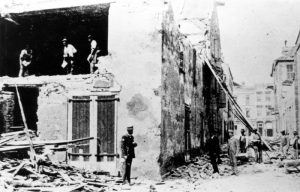 For some reason, there are certain areas on the United States, and the world, where earthquakes are…unexpected. There are just no real fault lines in these places, and no man-made reasons for it, like mining or drilling. So often people think they live in an area that is completely safe from an earthquake. Nevertheless, that does not mean that an earthquake can’t happen, as the people of Charleston, South Carolina found out on August 31, 1886.
For some reason, there are certain areas on the United States, and the world, where earthquakes are…unexpected. There are just no real fault lines in these places, and no man-made reasons for it, like mining or drilling. So often people think they live in an area that is completely safe from an earthquake. Nevertheless, that does not mean that an earthquake can’t happen, as the people of Charleston, South Carolina found out on August 31, 1886.
The first indicator that something strange was going on, came on August 27 and 28, when foreshocks were felt in Summerville, South Carolina, where my first cousin once removed, Stephanie Willard and her family live. While the tremors were odd, the people of the area didn’t think they were a warning for what was coming. Then, at 9:51pm on August 31, the rumbling began. The 7.6 magnitude quake was felt as far away as Boston, Chicago and Cuba. Buildings as far away as far away as Ohio and Alabama were damaged. But, it was Charleston, South Carolina, that took the biggest hit from the quake. Almost all of the buildings in town were seriously damaged. About 14,000 chimneys fell from the earthquake’s shaking. It caused multiple fires, and 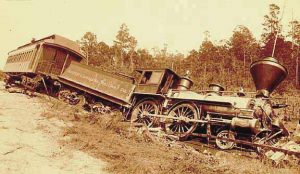 water lines and wells were ruptured. The total damage was in excess of $5.5 million, which would be about $112 million today.
water lines and wells were ruptured. The total damage was in excess of $5.5 million, which would be about $112 million today.
While that was a disaster in itself, it was the loss of life that was felt the worst. More that 100 people lost their lives that fateful day, and countless others were injured, in what is still the largest recorded earthquake in the history of the southeastern United States. The quake damaged as many as 2,000 buildings, including buildings as far away as central Alabama, central Ohio, eastern Kentucky, southern Virginia and western West Virginia. The strange part about this quake is the fact that there were no apparent surface cracks as a result of this tremor, railroad tracks were bent in all directions in some locations. Acres of land were liquefied. This quake remained a mystery for many years since there were no known underground faults for 60 miles in any direction. Then, as science and detection methods got better, scientists have recently uncovered a concealed fault along the coastal plains of Virginia and the Carolinas. While this fault is now known, scientists think that another quake of this magnitude remains highly 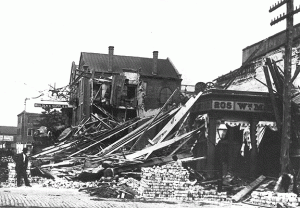 unlikely, though not impossible, in this location.
unlikely, though not impossible, in this location.
I guess I don’t quite understand that concept, except to say that if it is the only fault and has nothing to connect to, maybe there is less chance of a small tremor turning into a big quake, and maybe that is why they don’t expect another quake of that magnitude. Still, it is always good advise to realize that no place is immune to earthquakes. Oklahoma has found that out in recent years, as underground mining work has created quake situations that weren’t there before. It is still my hope that the Charleston area never has another quake like the one they had in 1886.
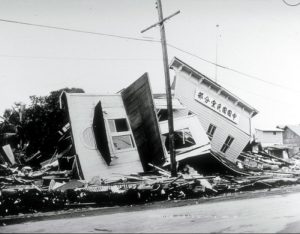
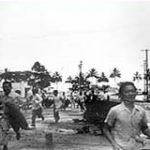 When most of us think about April Fool’s Day, we think of playing some funny prank on our family or friends, but on April Fool’s Day 1946, the Earth played a prank, if it could be called that, on Hawaii. It was a prank that wasn’t funny, and it would claim the lives of 159 people. Early in the morning of that April Fool’s Day, a 7.4 magnitude earthquake struck in the North Pacific, 13,000 feet beneath the ocean surface, and off Unimak Island in the Aleutian chain, that makes up the tail of Alaska. The quake triggered devastating tidal waves throughout the Pacific, and particularly aimed at Hawaii. The first tidal wave hit Unimak Island shortly after the quake struck. The wave was estimated to be almost 100 feet, and it crashed into a lighthouse 30 feet above sea level. Five people lived in the lighthouse. It was smashed to pieces, and all five were killed instantly. The wave then headed toward the Southern Pacific at 500 miles per hour. The situation was like a freight train carrying an atomic bomb.
When most of us think about April Fool’s Day, we think of playing some funny prank on our family or friends, but on April Fool’s Day 1946, the Earth played a prank, if it could be called that, on Hawaii. It was a prank that wasn’t funny, and it would claim the lives of 159 people. Early in the morning of that April Fool’s Day, a 7.4 magnitude earthquake struck in the North Pacific, 13,000 feet beneath the ocean surface, and off Unimak Island in the Aleutian chain, that makes up the tail of Alaska. The quake triggered devastating tidal waves throughout the Pacific, and particularly aimed at Hawaii. The first tidal wave hit Unimak Island shortly after the quake struck. The wave was estimated to be almost 100 feet, and it crashed into a lighthouse 30 feet above sea level. Five people lived in the lighthouse. It was smashed to pieces, and all five were killed instantly. The wave then headed toward the Southern Pacific at 500 miles per hour. The situation was like a freight train carrying an atomic bomb.
Hawaii was 2,400 miles south of the quake’s epicenter, and Captain Wickland of the United States Navy was the first person to spot the coming wave at about 7:00am, four and a half hours after the quake struck in the Aleutian Islands. His position on the bridge of a ship, 46 feet above sea level, put him at eye level with a “monster wave” that he described as two miles long. The first wave came in and receded, then the water in Hilo Bay seemed to disappear. The boats that were docked there, settled on the sea floor, surrounded by flopping fish. Then…the second wave hit…and it was massive!! The city of Hilo was hit by a 32 foot wave that devastated the town. Nearly a third of the city was completely destroyed. The bridge that crossed the Wailuku River was picked up by the wave, and pushed 300 feet away. In Hilo, 96 people lost their lives in the tsunami. Other parts of Hawaii were hit even worse. In some places, the waves reached heights of 60 feet. A schoolhouse in Laupahoehoe was crushed by the tsunami, killing the teacher and 25 students inside.
The massive wave was seen as far away as Chile, where, 18 hours after the quake near Alaska, unusually large waves crashed ashore, but there were no casualties. This tsunami prompted the United States to establish the Seismic SeaWave Warning System two years later, which is now known as the Pacific Tsunami Warning System. 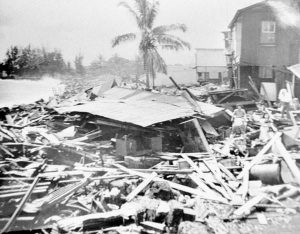
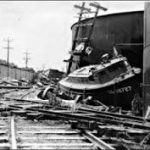 It uses undersea buoys throughout the ocean, in combination with seismic-activity detectors, to find possible killer waves. The warning system was used for the first time on November 4, 1952. That day, an evacuation was successfully carried out, but the expected wave never materialized. Still, like the fire drills we all know about from school, maybe Tsunami Drills wouldn’t be a bad thing either, especially if it would prevent the kind of loss of life that Hawaii experienced on that awful April Fool’s Day in 1946.
It uses undersea buoys throughout the ocean, in combination with seismic-activity detectors, to find possible killer waves. The warning system was used for the first time on November 4, 1952. That day, an evacuation was successfully carried out, but the expected wave never materialized. Still, like the fire drills we all know about from school, maybe Tsunami Drills wouldn’t be a bad thing either, especially if it would prevent the kind of loss of life that Hawaii experienced on that awful April Fool’s Day in 1946.

